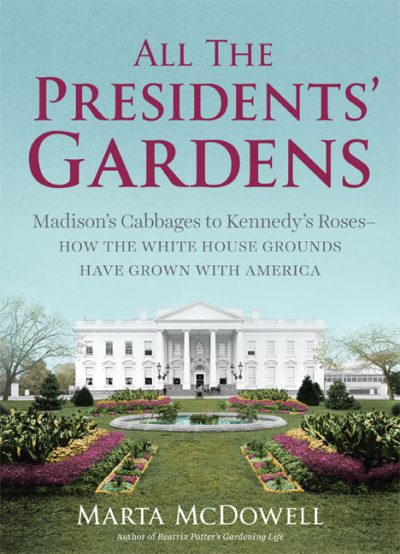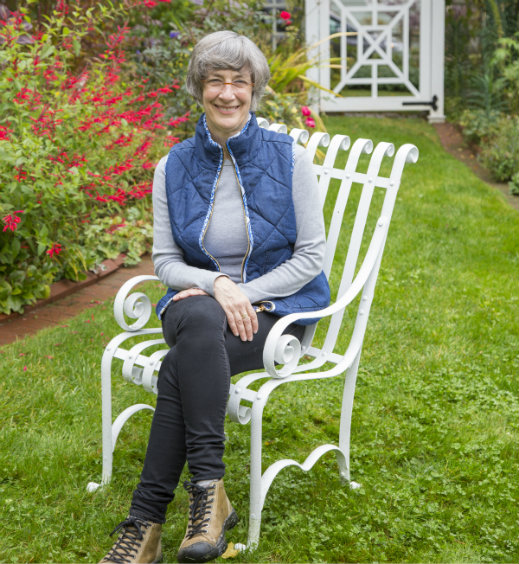
New Jersey author and gardener Marta McDowell’s new work All the Presidents’ Gardens: Madison’s Cabbages to Kennedy’s Roses—How the White House Grounds Have Grown with America is a perfect springtime porch read.
The Chatham resident is the author of several gardening books, including Beatrix Potter’s Gardening Life:The Plants and Places that Inspired the Classic Children’s Tales, and teaches classes on landscape history at the New York Botanical Garden. She worked as a horticulturist for five years at Reeves-Reed Arboretum in Summit, and is on the Board of the New Jersey Historical Garden Foundation at the Cross Estate in Bernardsville.
Her newest work, All the Presidents’ Gardens, starts with a short history lesson of how our founders chose the rural plot of land on the Potomac River for the new nation’s capitol. Many complained it was too wooded and isolated compared to the cosmopolitan luxuries of Philadelphia, but the virgin southern real estate allowed the founders to build a city from scratch.
McDowell traces how the gardening preferences of America’s leaders shift depending on the trends of the times. One example is the fascinating story of sowing a relationship with Japan by importing thousands of cherry blossom trees. The spectacular placement of the bright pink trees along the Tidal Basin—all thanks to First Lady Helen Taft—is still celebrated today with the popular annual Cherry Blossom Festival (though its worth noting that Newark’s Branch Brook Park has an even larger collection of cherry trees). The book ends with a “1990s and Beyond” chapter, covering Hillary Clinton’s desire to add eight sculpture exhibitions (which all had to be approved by the Secret Service) and Michelle Obama’s nutrition initiative, the White House Kitchen Garden.
Woodrow Wilson, who was president of Princeton University from 1902-1910, then governor of New Jersey from 1911 to 1913, and then President of the United States from 1913 to 1921, had a particularly feminist chapter in the White House’s garden history.
After Wilson was inaugurated in March 1913, First Lady Ellen Axson Wilson quickly decided Beatrix Farrand (then Jones), the only woman among the founding members of the American Society of Landscape Architects, should be the White House landscape architect of the Wilson presidency. Ellen had met Beatrix previously at Princeton University, and Beatrix was actually hired as the consulting landscape architect for the university in 1912. As the campus guide explains, “Farrand believed that nature was to the spirit what books were to the mind.” Farrand’s work on the Princeton campus is still the guiding principle of the university’s landscaping today.

Beatrix Farrand’s revised presentation plans for the White House garden. Credit University of California, Berkeley
We spoke with McDowell about her garden in Chatham, her favorite gardens in the state and, of course, her pick for the best White House garden.
New Jersey Monthly: Could you tell me a little bit about your home garden in Chatham, and what inspired the design and landscaping?
Marta McDowell: My garden is on a small lot that surrounds a 1930s Sears house. The front yard is shaded by enormous Norway spruces that were there when we bought the house 25 years ago, thus it has a shade garden—lots of little spring bulbs, ferns, hellebores, and some native plants.
Around the side and back is the flower garden, loose and cottage-y. Roses and clematis, old fashioned shrubs like lilacs, spiraea and beautybush. As I’m interested in writers who gardened, I grow some of the plants they grew: daylilies for Emily Dickinson, honesty (money plant) for Beatrix Potter, wild irises for Laura Ingalls Wilder. And last fall, I put in a collection of tulips that were planted in the White House rose garden for John F. Kennedy. They are just coming into bloom now. (Did I mention that part has a deer fence?)
Farther back there is a tiny woods, full of narcissus in the spring. I’ve evicted many invasive woody plants, like barberry, and replaced them with native shrubs—redbud and summersweet. I also treasure plants from friends, and plants with family connections—my great aunt Mary grew tiger lilies (Lilium superbum), so I think of her every year when they bloom. Along our driveway I have been replacing some old pachysandra with a quirky little herb and vegetable garden. But most of my vegetables, including lots of tomatoes, are in a plot at the Chatham Community Garden and another run by Frelinghuysen Arboretum.

Marta McDowell. Photo by Marco Ricca
NJM: What are your favorite gardens in New Jersey?
MM:
Branch Brook Park, Newark
Van Vleck House and Garden, Montclair
Presby Iris Garden, Montclair
Greenwood Gardens, Short Hills
Reeves-Reed Arboretum, Summit
Frelinghuysen Arboretum, Morristown
Miss Foster’s Garden at Fosterfield, Morristown
Macculloch Hall, Morristown
Cross Estate Garden, Bernardsville
Willowwood Arboretum, and neighboring Bamboo Brook, Far Hills
Leonard J. Buck Garden, Far Hills
Princeton University campus, Princeton
Morven Garden, Princeton
NJM: What is your favorite plant?
MM: Twinleaf—Jeffersonia diphylla, named in honor of Thomas Jefferson. So beautiful when it emerges a sort of purple, maturing to green. Sweet flowers, interesting seed pods, and it is native.
NJM: Favorite flower?
MM: Black Parrot tulips. I am smitten with them.
NJM: Favorite tree?
MM: American beech. It grows in the woods behind our house, with silvery bark and leaves that dry and persist all winter. I admire it in the long cold months when nothing else is growing.
NJM: Which was your favorite of all the Presidents Gardens?
MM: The garden opposite the Rose Garden along the East Wing. It was designed by Rachel Lambert “Bunny” Mellon for Jacqueline Kennedy. Mellon was inspired by a set of topiaried hollies, which reminded her of the scene in Alice in Wonderland where they play croquet with flamingo mallets. Mrs. Kennedy mentioned she wanted a space for the children to play croquet, and so a design was born. It is especially poignant since the garden was about to be put in November, 1963 when the Kennedys went to Dallas. It wasn’t planted until the Johnson administration.
I’ve just learned that the young Rachel Mellon (then Lambert) learned to garden at her family’s home, the Albemarle estate in Princeton, with a landscape designed by the Olmsted firm. Frederick Law Olmsted designed Central Park, but he also designed Branch Brook Park (one of my favorites), the first county park system in America for Essex County, New Jersey. We’re not called the Garden State for nothing!
All the Presidents’ Gardens is available on April 27, 2016.
Catch Marta McDowell discussing her book at any of these upcoming appearances:
April 19: Madison Historical Society, Chase Room, Library, Madison 7:30 pm
May 11: Town and Country Garden Club, Frelinghuysen Arboretum, Morristown 11 am
June 2: Little City Books, Bloomfield Street, Hoboken 7 pm
June 5: Short Stories Book Hub, Main Street, Madison 2 pm
June 11: Labyrinth Books, Princeton 3 pm
Sept 25: Friends of Fosterfields, Morristown TBD
Sept 27: Bernards Township Library, The Pen and the Trowel, Bernardsville 7 pm
Oct 19 Garden Club of Morristown, Morristown TBD
Oct 27: Cross Estate Fall Talk & Tea, Presbyterian Church, New Vernon 1 pm
Nov 10: Bernards Township Library, Bernardsville 7 pm
Jan 15, 2017: Friends of Frelinghuysen, Morris Township TBD
Jan 18, 2017: Chatham Perennial Garden Club, Chatham Library, Chatham 1 pm
March 25, 2017: Friends of Laurelwood Arboretum, Knippenberg Center, Wayne 1 pm



